Keywords
Environment; Fresh water; Fishes; Parasites
Introduction
Parasites are ubiquitous animals whose life cycle was dependent on one or several host organisms. However, they are not merely passive passengers but active members of ecosystems. Parasites are believed to play a significant role in the evolution of sexual selection and the immune system and maintaining the genetic diversity of their hosts (Poulin, 2007).
Parasites shape the population and community dynamics of their hosts, affect the allocation of energy in food webs and maintain biodiversity (Hudson et al., 2006). Parasitism is assumed to cause costs to the hosts, but manipulation of the hosts is also suggested to cause costs to the parasite itself (Poulin et al., 2005). Cultured fish are continuously affected by environmental fluctuation and management practices such as fluctuating temperature, poor water quality and handling. Those factors could impose considerable stress on the homeostatic mechanisms of fish, rendering them susceptible to a wide variety of parasites (Pampoulie et al., 2004). Fish pathogens are responsible for the majority of mortalities incurred beyond larval stages. Several factors play role in enhancing the susceptibility and damage caused by, diseases in fish farming operations. Firstly, high stocking density typical of aquaculture farms results in extremely close proximity between fish, greatly enhancing the physical spread of pathogens between livestock (Pulkkinen et al., 2010). It is necessary to have understanding of water quality in order to successfully diagnose and correct aquarium diseases. Stress has been linked as primary contributing factor of fish disease and mortality in aquaculture (Petric et al., 2006). Among the various physical factors affecting the aquatic environment, temperature is paramount importance and considered as the abiotic master factor for fishes (Brett, 1979). The present study aid to: 1) collect qualitative data on the parasitic fauna of the freshwater fishes in Egypt; 2) study seasonality of parasites according to prevalence with age and sex of the fish.
Methodology
Study area
This study was conducted at the central laboratory for aquaculture research at El-Abbassa, Abu-Hammad, Sharkia Governorate, Egypt, on fish farm of culture intensive system (Figure 1).
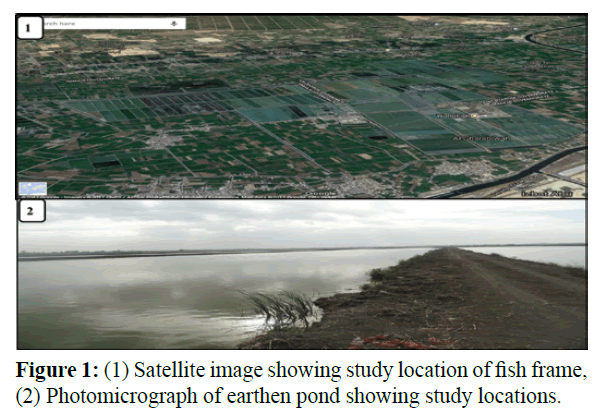
Figure 1: (1) Satellite image showing study location of fish frame, (2) Photomicrograph of earthen pond showing study locations.
Collection of fish samples
A total of 1828 cultured fish species were represented as 694 Clarias gariepinus, 288 Cyprinus Carpio and 846 Oreochromis niloticus was collected seasonally from October 2015 to September 2017. Fish were transferred alive to the laboratory. In the laboratory, the species was selected carefully to cover feeding habits, the individuals of the three species were selected seasonally to cover two categories; firstly sized groups. One of these was small sized group (25-39.9 cm) for C. gariepinus, (12- 21.9 cm) for C. Carpio and (14-21 cm) for O. niloticus, while, the large sized group; being 40-55 cm for C. gariepinus, 22 -33 cm for C. Carpio and from 22-30 cm for O. niloticus. The second category as according to sex.
Water analysis
Water temperature (T) and dissolved oxygen (DO) were measured by oxygen meter (Model YSI 55) with oxygen and temperature probe. Hydrogen ion concentration (pH) was detected using pH meter (Model 301). Conductivity by tintometer group. Total alkalinity and total hardness were determined by titration method according to APHA (2000). Nitrate was detected using spectrophotometer (model, WPA) as described by (APHA, 2000). Ammonia was determined by Hach comparison apparatus following the method reported by APHA (2000) and orthophosphate was measured according to APHA (2000) by using spectrophotometer (model, WPA). H2S detected by titration. Oxygen consumption by measurement of BOD and COD. Total bacterial count by using general media and counting.
Clinical examination
First, weight and total length of the examined fish species were recorded and then clinical examination was done on the live fishes or freshly dead ones. Fish specimens under investigation were grossly examined for determination of any clinical abnormalities and any external parasites or visible cysts according to the methods described by Amlacker, (1970).
Postmortem examination
For recording the internal abnormalities, the postmortem examination was performed on all fishes according to Amlacker, (1970).
Identification of the isolated parasites
• Protozoa identified according to Ahmed et al., (2000).
• Monogenatic trematodes identified according to Eissa, (2002).
• Encysted metacercariae identified according to Ramadan et al., (2004).
• Cestode and nematoda identified according to Paperna, (1996).
• Acanthocephala identified according to Ramadan, (1994).
• Crustacean parasites identified according to Eissa, (2002).
Results
Physico-chemical parameters
Results (Table 1) revealed that, maximum average value of surface water temperature in the fish farm was recorded during summer. It decreased suddenly during spring and reached its minimum values during autumn and winter. The highest average value of hydrogen ion concentrations in the water of this farm was recorded during winter. It decreased slightly during autumn through summer and reached its lowest value during spring, however, turbidity in waters of the fish farm was raised from 44.17 ± 7.04% during spring to 75.86 ± 4.69% during winter. During autumn and summer, water turbidity was 73.99 ± 5.5 and 56.52 ± 4.13%, respectively. The highest average value of conductivity was recorded during winter; it decreased gradually during spring through autumn and reached its lowest value during summer. Also, Results showed that, total dissolved solid was peaked during winter (853.33 ± 108.03 mg/L). It decreased gradually during autumn (824.00 ± 160.15 mg/L) through spring (754.00 ±59.00 mg/L) and reached its lowest value (632.00 ± 95.64 mg/L) during summer. On other hand, total ammonia in the water increased from 0.74 ± 0.07 mg/L during spring to 0.85 ± 0.07 mg/L and 0.86 ± 0.05 mg/L during winter and autumn, respectively and reached its maximum value (1.27 ± 0.42 mg/L) during summer. The present study revealed that, nitrite in the waters of fish farm was ranged between 0.02 ± 0.01mg/L during spring and 0.04 ± 0.02 mg/L during autumn. Concerning, nitrate concentration, the lower level was recorded during spring (0.49 ± 0.07 mg/L). It increased gradually during autumn (0.56 ± 0.14 mg/L) through winter (0.70 ± 0.11 mg/L) and reached its higher concentration during summer (0.83 ± 0.06 mg/L), the maximum concentration of total alkalinity in water of the fish farm was recorded during summer; it decreased gradually during winter and reached its minimum concentration during spring, however, the highest values of permanent and temporary hardness were recorded during winter and their lowest value was observed during spring. Total hardness was peaked during winter, it decreased gradually during autumn and summer, and reached its lower peak during spring. Data exhibited that, the minimum value of silica in the waters of fish farm was recorded during spring, it increased gradually during autumn through winter and reached its maximum value during summer, and also the highest average value of total phosphates was detected during winter and reached its lowest value during spring. The highest average value of total phosphates was detected during winter (0.17 ± 0.03 mg/L and reached its lowest value (0.09 ± 0.02 mg/L) during spring. Hydrogen sulfide in the fish water was decreased from 1.02 ± 0.13 mg/L during winter to (0.72 ± 0.16 mg/L) during spring, the lowest concentration of dissolved oxygen during summer (6.42 ± 0.69 mg/L) and the highest one (8.94 ± 0.75 mg/L) during winter. Elsewhere, however, the minimum value of oxygen consumed in the water of fish farm was observed during spring (6.01 ± 0.22 mg/L) and reached its maximum value during winter (8.12 ± 0.39 mg/L) and results revealed that, total bacterial count in the fish farm was peaked during autumn and reached its minimum one during winter and spring.
| Seasons |
Spring |
Summer |
Autumn |
Winter |
Annual average |
| Temperature (ºC) |
23.24 ± 1.35 |
28.14 ± 1.45 |
22.49 ± 1.29 |
16.43 ± 1.12 |
22.57 ± 1.30 |
| pH |
7.23 ± 0.30 |
7.57 ± 0.52 |
8.24 ± 0.35 |
8.77 ± 0.47 |
7.95 ± 0.41 |
| Turbidity (%) |
44.17 ± 7.04 |
56.52 ± 4.13 |
73.99 ± 5.57 |
75.86 ± 4.69 |
62.63 ± 5.36 |
| Conductivity (µs/cm) |
1148.67 ± 128.02 |
957.67 ± 144.67 |
1047.00 ± 416.91 |
1301.67 ± 267.90 |
1113.75 ± 239.3 |
| TDS ( mg/L) |
754.00 ± 59.00 |
632.00 ± 95.64 |
824.00 ± 160.15 |
853.33 ± 108.03 |
765.83 ± 105.70 |
Total ammonia
{NH3( mg/L) |
0.74 ± 0.07 |
1.27± 0.42 |
0.86 ± 0.05 |
0.85 ± 0.07 |
0.93 ± 0.15 |
| NO2 (mg/L) |
0.02 ± 0.01 |
0.03 ± 0.02 |
0.04 ± 0.02 |
0.03 ± 0.02 |
0.029 ± 0.018 |
| NO3(mg/L) |
0.49 ± 0.07 |
0.83 ± 0.06 |
0.56 ± 0.14 |
0.70 ± 0.11 |
0.64 ± 0.09 |
| Total alkalinity (mg/L) |
176.00 ± 20.30 |
242.67 ± 33.55 |
200.00 ± 26.00 |
222.00 ± 21.93 |
210.17 ± 25.44 |
| Permanent hardness (mg/L) |
23.00 ± 2.65 |
32.67 ± 5.69 |
34.00 ± 7.00 |
44.00 ± 10.44 |
33.42 ± 6.44 |
| Temporary hardness (mg/L) |
195.33 ± 7.37 |
203.67 ± 5.51 |
207.00 ± 24.33 |
212.33 ± 18.01 |
204.58 ± 13.80 |
Total hardness
(mg/L) |
218.33 ± 5.03 |
236.33 ± 10.21 |
241.00 ± 18.25 |
256.33 ± 27.06 |
238 ± 15.14 |
| Silica (mg/L) |
7.63 ± 0.46 |
13.43 ± 3.76 |
8.97 ± 2.10 |
9.64 ± 2.13 |
9.92 ± 2.11 |
| Phosphate (mg/L) |
0.09 ± 0.02 |
0.14 ± 0.03 |
0.13 ± 0.02 |
0.17 ± 0.03 |
0.132 ± 0.022 |
| H2S (mg/L) |
0.72 ± 0.16 |
0.88 ± 0.21 |
0.96 ± 0.16 |
1.02 ± 0.13 |
0.90 ± 0.16 |
| Oxygen consumed O2 (mg/L) |
6.01 ± 0.22 |
6.57 ± 0.15 |
7.77 ± 0.57 |
8.12 ± 0.39 |
7.12 ± 0.33 |
| Dissolved Oxygen (mg/L) |
6.85 ± 0.45 |
6.42 ± 0.69 |
8.36 ± 0.63 |
8.94 ± 0.75 |
7.64 ± 0.63 |
| Total bacterial counts (Unit/ml ) |
1066.67 ± 65.90 |
1886.67 ± 160.42 |
3483.33 ± 340.34 |
1853.67 ± 189.69 |
2072.6 ± 189.1 |
Table 1: Seasonal variations of physic-chemical parameters in Abbassa Fish Farm.
Seasonal variations of parasitic infection in different studied fishes
Data (Table 2 and Figures 2) indicated that, total prevalence of parasites infection of C. gariepinus, was peaked during summer and declined during winter; being; 87.82 and 55.81%, respectively. In the case of C. Carpio, the highest value of total parasitic infection was observed during summer (70.79%) and the lowest during autumn (33.33%). Concerning to O. niloticus, however, total parasitic infection showed the maximal peak during summer (80.06%) and the minimal value during winter (53.51%) (Plate 1) (Figures 3-9).
| Season |
Clarias gariepinus |
Cyprinus Carpio |
Oreochromis niloticus |
| No. of examined |
No. of infected |
% |
No. of examined |
No. of infected |
% |
No. of examined |
No. of infected |
% |
| Spring |
186 |
147 |
79.03 |
103 |
52 |
50.49 |
214 |
132 |
61.68 |
| Summer |
271 |
238 |
87.82 |
89 |
63 |
70.79 |
321 |
257 |
80.06 |
| Autumn |
151 |
114 |
75.5 |
54 |
18 |
33.33 |
197 |
118 |
59.9 |
| Winter |
86 |
48 |
55.81 |
42 |
21 |
50 |
114 |
61 |
53.51 |
| Total |
694 |
547 |
78.82 |
288 |
154 |
53.47 |
846 |
568 |
67.14 |
Table 2: Effect of season on the prevalence of parasites among examined fish species collected from Abbasa Fish Farm, Sharkia.
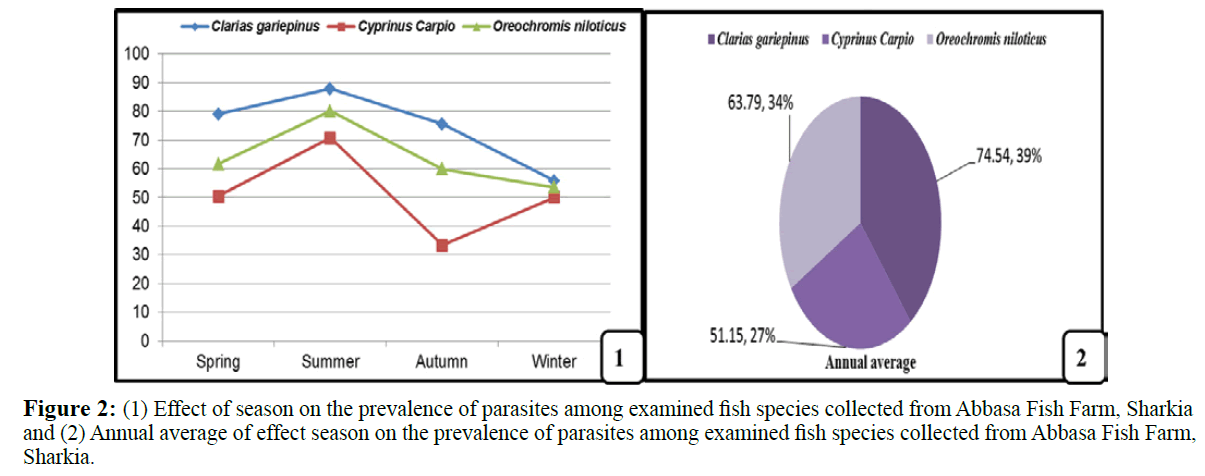
Figure 2: HPLC chromatogram of the nine reference compounds in 50% aqueous methanol, measured at 370nm. Retention times for rutin, sutherlandin A, sutherlandin B, kaempferol-3-O-rutinoside, sutherlandin C, sutherlandin D, quercitrin, quercetin and kaempferol were 11.9, 12.7, 13.8, 15.3, 16.2, 17.0, 18.0, 26.2 and 28.1 minutes, respectively.
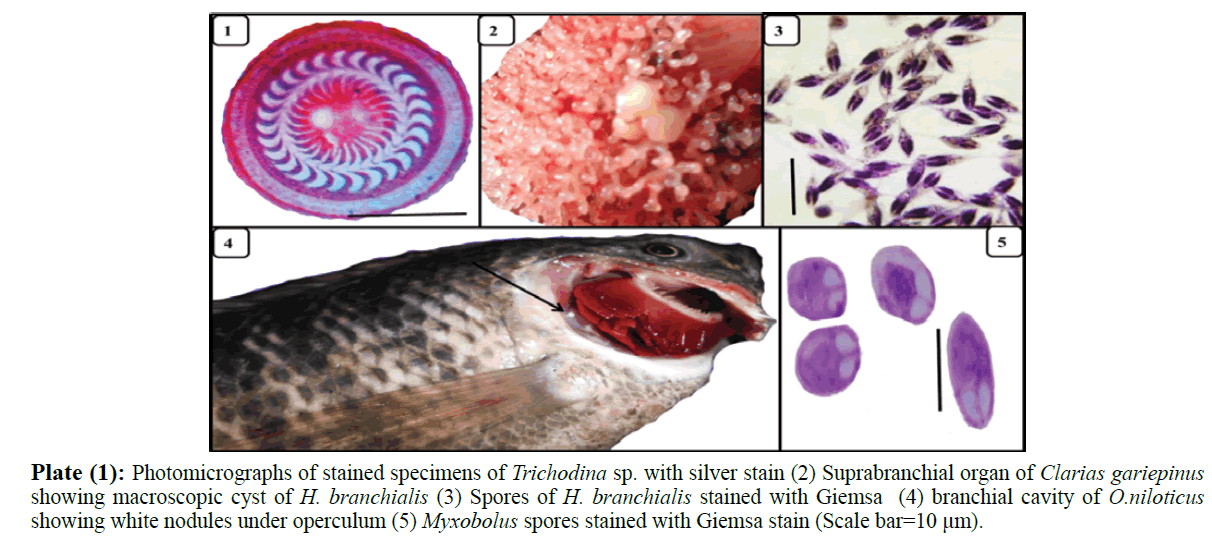
Plate (1): Photomicrographs of stained specimens of Trichodina sp. with silver stain (2) Suprabranchial organ of Clarias gariepinus showing macroscopic cyst of H. branchialis (3) Spores of H. branchialis stained with Giemsa (4) branchial cavity of O.niloticus showing white nodules under operculum (5) Myxobolus spores stained with Giemsa stain (Scale bar=10 μm).
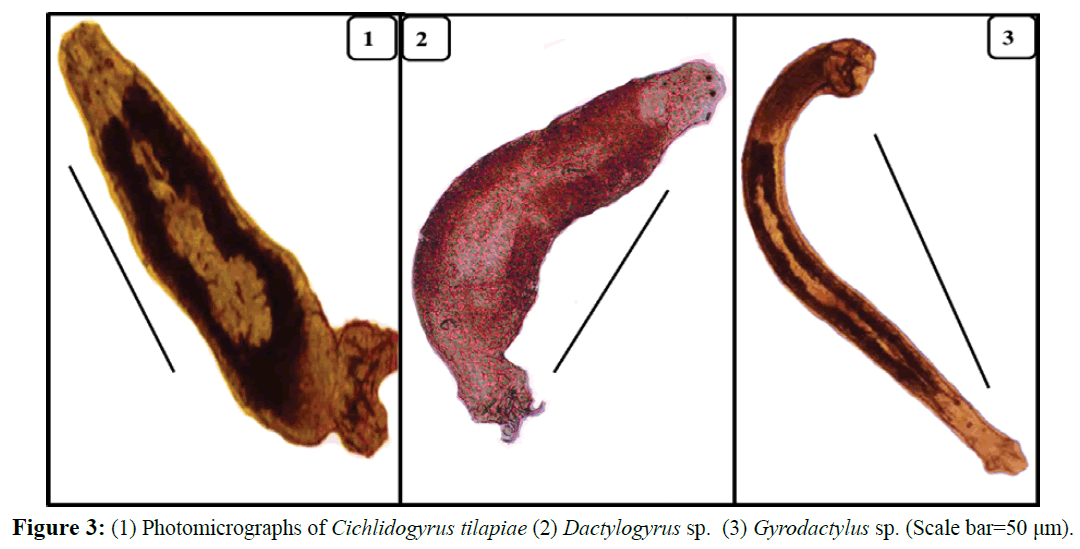
Figure 3: (1) Photomicrographs of Cichlidogyrus tilapiae (2) Dactylogyrus sp. (3) Gyrodactylus sp. (Scale bar=50 μm).
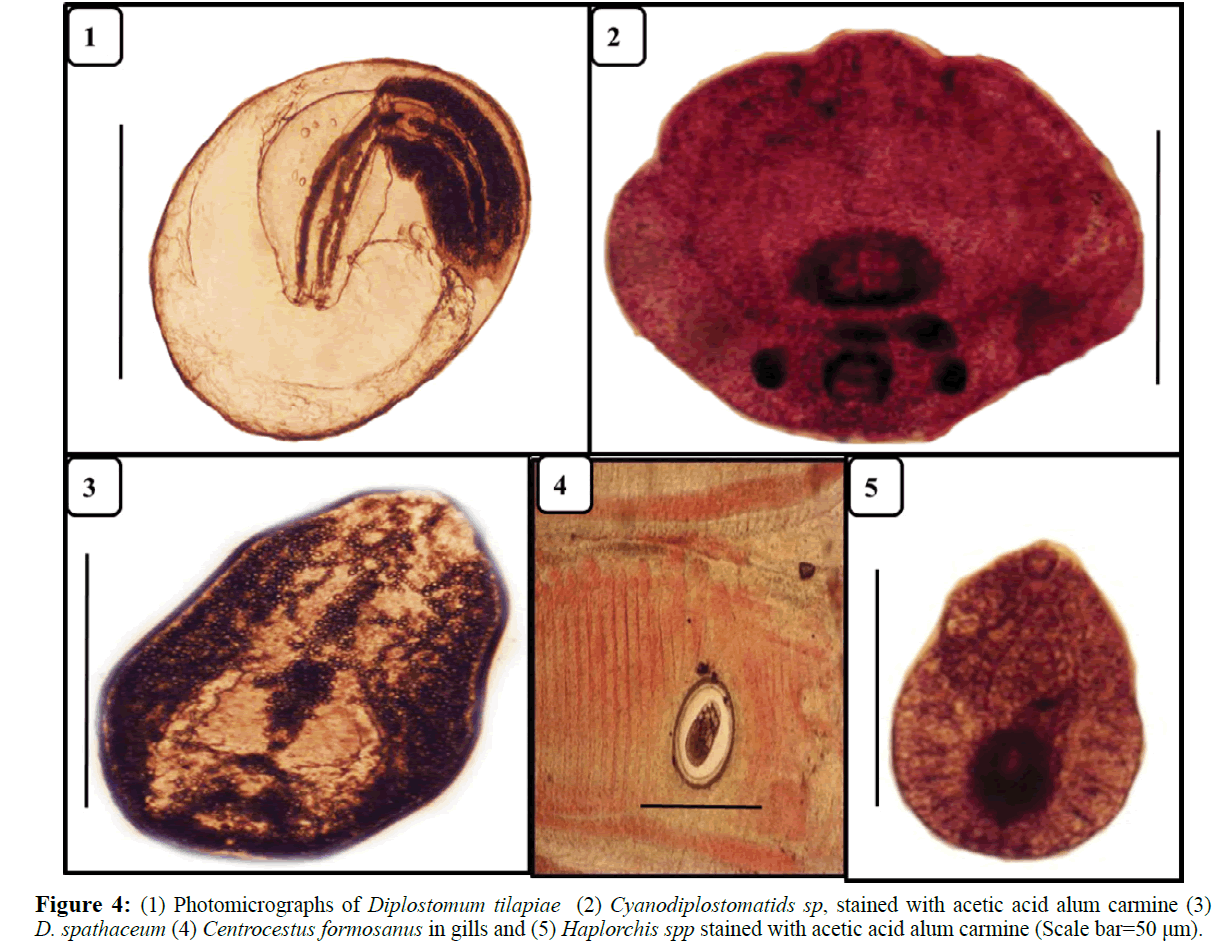
Figure 4: (1) Photomicrographs of Diplostomum tilapiae (2) Cyanodiplostomatids sp, stained with acetic acid alum carmine (3) D. spathaceum (4) Centrocestus formosanus in gills and (5) Haplorchis spp stained with acetic acid alum carmine (Scale bar=50 μm).
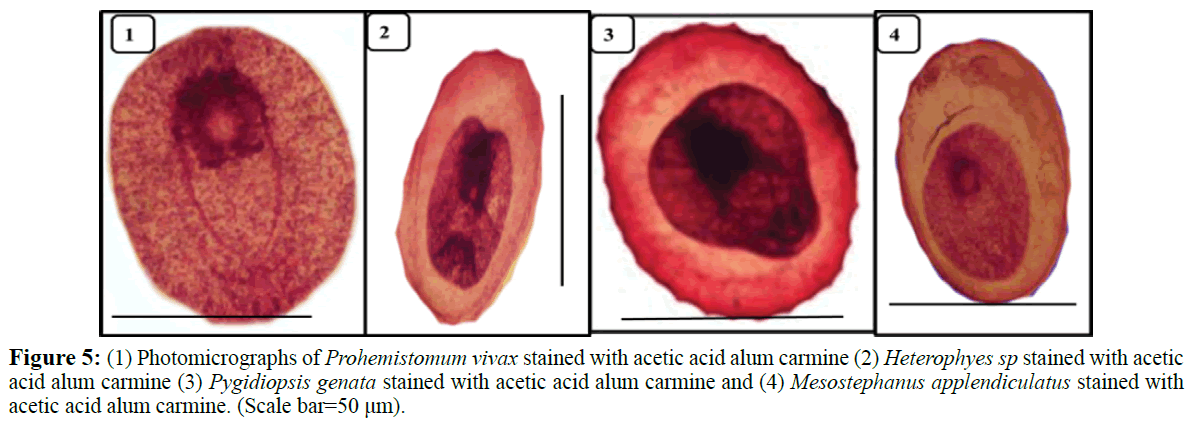
Figure 5: (1) Photomicrographs of Prohemistomum vivax stained with acetic acid alum carmine (2) Heterophyes sp stained with acetic acid alum carmine (3) Pygidiopsis genata stained with acetic acid alum carmine and (4) Mesostephanus applendiculatus stained with acetic acid alum carmine. (Scale bar=50 μm).
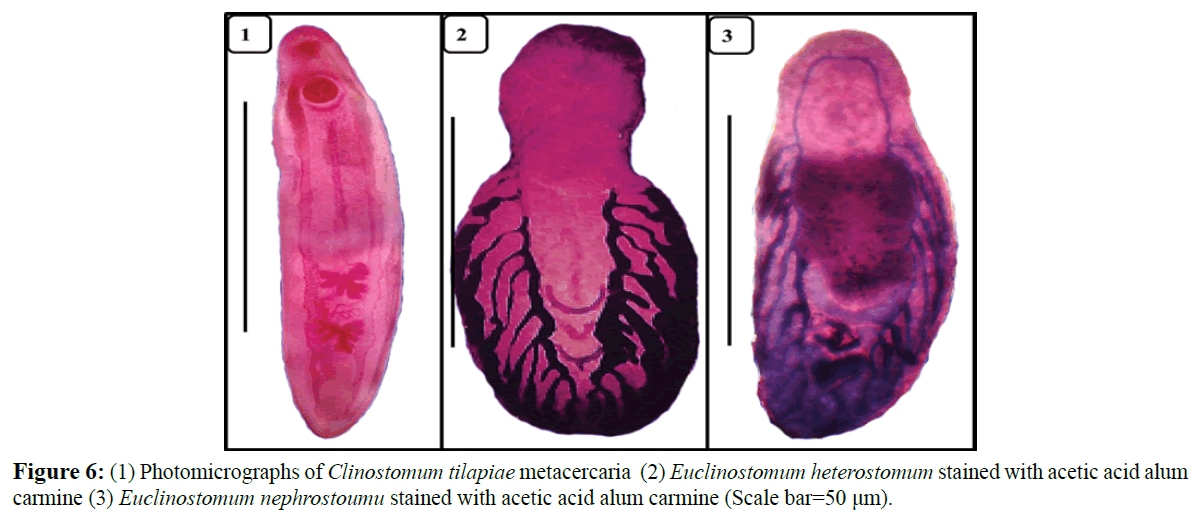
Figure 6: (1) Photomicrographs of Clinostomum tilapiae metacercaria (2) Euclinostomum heterostomum stained with acetic acid alum carmine (3) Euclinostomum nephrostoumu stained with acetic acid alum carmine (Scale bar=50 μm).
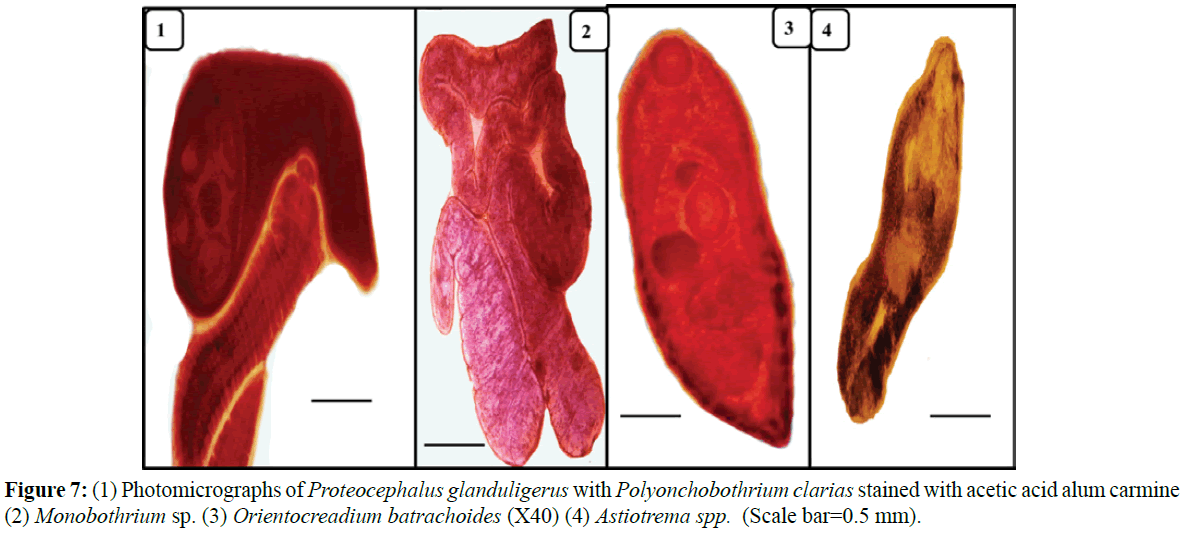
Figure 7: (1) Photomicrographs of Proteocephalus glanduligerus with Polyonchobothrium clarias stained with acetic acid alum carmine (2) Monobothrium sp. (3) Orientocreadium batrachoides (X40) (4) Astiotrema spp. (Scale bar=0.5 mm).
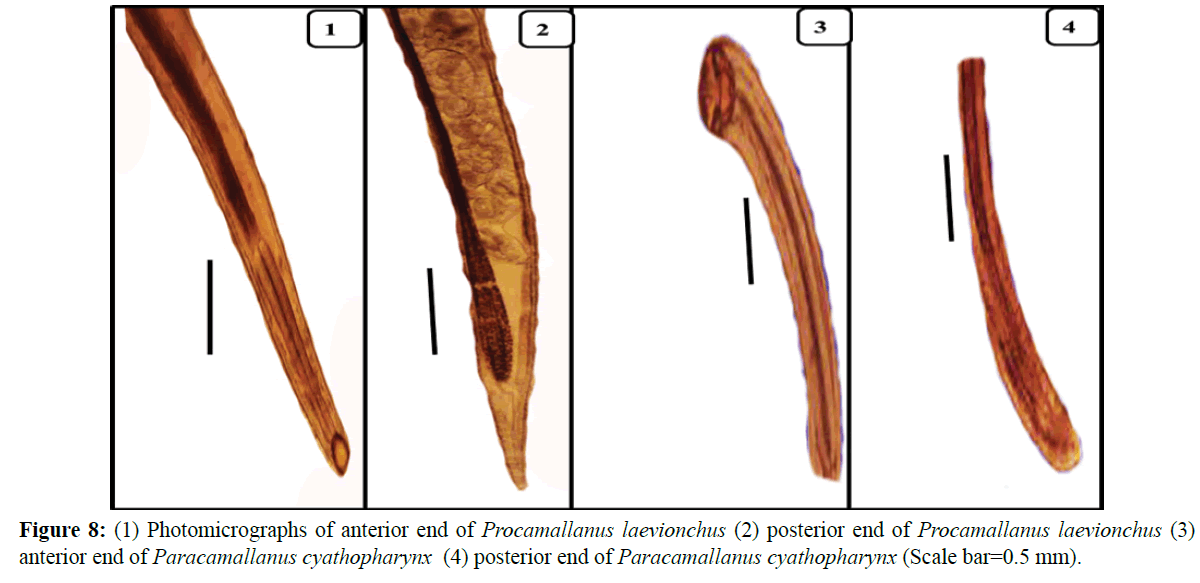
Figure 8: (1) Photomicrographs of anterior end of Procamallanus laevionchus (2) posterior end of Procamallanus laevionchus (3) anterior end of Paracamallanus cyathopharynx (4) posterior end of Paracamallanus cyathopharynx (Scale bar=0.5 mm).
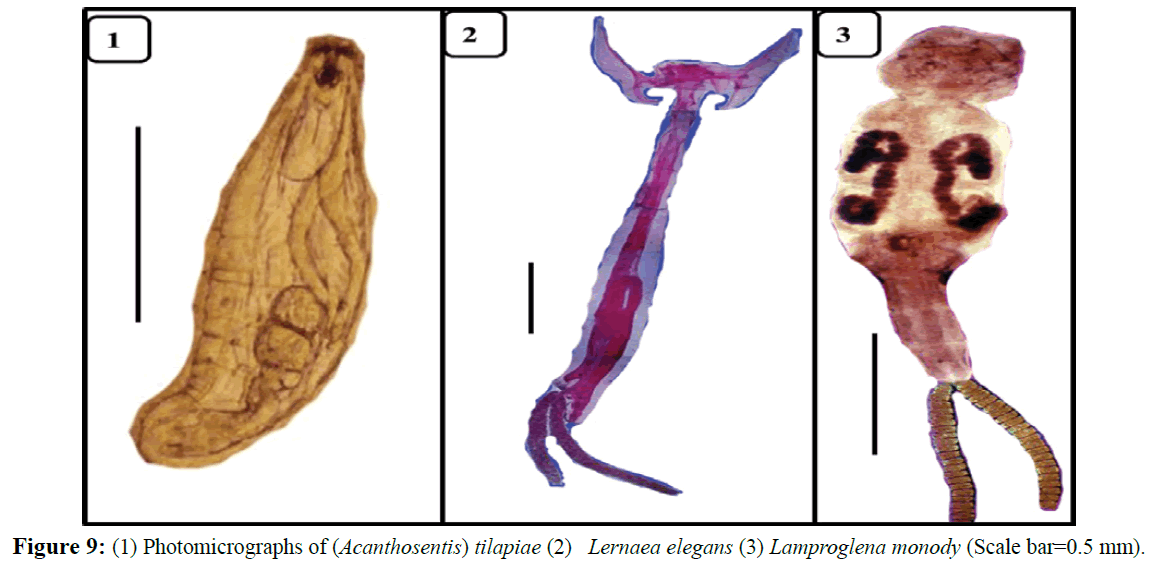
Figure 9: (1) Photomicrographs of (Acanthosentis) tilapiae (2) Lernaea elegans (3) Lamproglena monody (Scale bar=0.5 mm).
Regards to seasons the annual average of parasites infection in the studies fishes the higher value (74.54%) were recorded in C. gariepinus, then decreases gradually in O. niloticus, (63.79%) and reached the lowest value (51.15%) in C. Carpio. In general, results indicated that, the total prevalence of parasites among examined fish species was representing as the following C. gariepinus O. niloticus C. Carpio, also can be ordered as the following: summer spring autumn winter.
Relationship between seasonal variations and percentage parasites infection of examined fish species according to sex and sized groups
Results (Table 3) showed that, the percentage parasite infection of C. gariepinus are varied considerably according to sized and sex groups. The maximal percentage parasite infection in small fishes of C. gariepinus was recorded in female samples (92%) during summer and the lowest (55.56%) during winter in the male of the same sized. In the large fishes, however it was varied from 41.18 during winter to 90.24% summer in the male groups. The maximum average values of parasite infection were observed during summer in the small of females and the minimum average values were detected during winter in the large female group; being 84.77% & 70.39%, respectively. Also, it’s higher in small size than in the large sized. The highest percentage of parasite infection in C. Carpio, was recorded in small fishes of female during summer and the minimal value was observed in the large fishes of male during the autumn; being 77.42% and 16.67%, respectively. Results exhibited that, the maximum average percentage of parasite infection was recorded in the small females (62.63%); it decreased gradually in the small and large of male (50%) and reached its minimum value in the large females (45.90%) (Table 4). Results (Table 5) Revealed that, the percentage parasite in O. niloticus, was peaked in male small one during summer and declined in large of male during winter; being 84% and 35%, respectively. Results indicated that, the highest average values of parasite in the male and female of O. niloticus, were recorded in small fishes (67.92 and 68.49%, respectively) and the lowest values were observed in the large samples of the sexes (65.43and 65.22%, respectively).
| Size |
Sex |
No |
Spring |
Summer |
Autumn |
Winter |
Total |
| Small fish |
Male |
No. of examined |
50 |
71 |
38 |
18 |
177 |
| No. of Infected |
38 |
63 |
31 |
10 |
142 |
| Percentage of infection % |
76.00 |
88.73 |
81.58 |
55.56 |
80.23 |
| Female |
No. of examined |
61 |
101 |
54 |
27 |
243 |
| No. of Infected |
51 |
93 |
42 |
20 |
206 |
| Percentage of infection % |
83.61 |
92.08 |
77.78 |
74.07 |
84.77 |
| Large fish |
Male |
No. of examined |
34 |
41 |
30 |
17 |
122 |
| No. of Infected |
27 |
37 |
21 |
7 |
92 |
| Percentage of infection % |
79.41 |
90.24 |
70.00 |
41.18 |
75.41 |
| Female |
No. of examined |
41 |
58 |
29 |
24 |
152 |
| No. of Infected |
31 |
45 |
20 |
11 |
107 |
| Percentage of infection % |
75.61 |
77.59 |
68.97 |
45.83 |
70.39 |
Table 3: Relationship between seasonal variations and percentage parasites infection of C. gariepinus collected fromAbbasa Fish Farm, Sharkia, according to sex and sized groups.
| Size |
Sex |
No |
Spring |
Summer |
Autumn |
Winter |
Total |
| Small |
Male |
No. of examined |
24 |
21 |
14 |
9 |
68 |
| No. of infected |
12 |
14 |
4 |
4 |
34 |
| Percentage of infection% |
50.00 |
66.67 |
28.57 |
44.44 |
50.00 |
| Female |
No. of examined |
35 |
31 |
19 |
14 |
99 |
| No. of infected |
21 |
24 |
8 |
9 |
62 |
| Percentage of infection% |
60.00 |
77.42 |
42.11 |
64.29 |
62.63 |
| Large |
Male |
No. of examined |
18 |
19 |
12 |
11 |
60 |
| No. of infected |
10 |
13 |
2 |
5 |
30 |
| Percentage of infection% |
55.56 |
68.42 |
16.67 |
45.45 |
50.00 |
| Female |
No. of examined |
26 |
18 |
9 |
8 |
61 |
| No. of infected |
9 |
12 |
4 |
3 |
28 |
| Percentage of infection % |
34.62 |
66.67 |
44.44 |
37.50 |
45.90 |
Table 4: Relationship between seasonal variations and percentage parasites infection of Cyprinus Carpio, collected from Abbasa Fish Farm, Sharkia, according to sex and sized groups.
| Size |
Sex |
No |
Spring |
Summer |
Autumn |
Winter |
Total |
| Small |
Male |
No. of examined |
24 |
21 |
14 |
9 |
68 |
| No. of infected |
12 |
14 |
4 |
4 |
34 |
| Percentage of infection% |
50.00 |
66.67 |
28.57 |
44.44 |
50.00 |
| Female |
No. of examined |
35 |
31 |
19 |
14 |
99 |
| No. of infected |
21 |
24 |
8 |
9 |
62 |
| Percentage of infection% |
60.00 |
77.42 |
42.11 |
64.29 |
62.63 |
| Large |
Male |
No. of examined |
18 |
19 |
12 |
11 |
60 |
| No. of infected |
10 |
13 |
2 |
5 |
30 |
| Percentage of infection% |
55.56 |
68.42 |
16.67 |
45.45 |
50.00 |
| Female |
No. of examined |
26 |
18 |
9 |
8 |
61 |
| No. of infected |
9 |
12 |
4 |
3 |
28 |
| Percentage of infection % |
34.62 |
66.67 |
44.44 |
37.50 |
45.90 |
Table 5: Relationship between seasonal variations and percentage parasites infection of Oreochromis niloticus, collected from Abbasa Fish Farm, Sharkia, according to sex and sized groups.
Isolated parasites from the examined fishes
The identified parasites were Protozoa (Trichodina sp, Myxobolus tilapiae and Henneguya branchialis), Monogeneatic trematodes (cichlidogyrus tilapiae, Gyrodactylus sp. and Dactylogyrus sp.), Digenetic trematodes (Metacercaria (Diplostomum tilapiae, D. spathacaum, Cyanodiplostomum azimi Clinostomum tilapiae, Euclinostomum heterostomum, Euclinostomum nephrostoumu Centrocestus formosanus, Haplorichis sp., Heterphyes sp., Pygidiopsis genata, Prohemostomum vivax, Mesostephanus appendiculatus), Adult (Astiotrema sp., Orientocreadium batrachoides, Cestoda, (Proteocephalus glanduligerus, Polyonchobothrium clarias and Monobothrioides sp.), Nematoda, (Procamallanus laevionchus and Paracamallanus cyathopharynx) Acanthocephala (Acanthosentis tilapiae) and Crustacea (Lernaea elegans and Lamproglena monodi).
Discussion
Parasites are attracting increasing interest from parasite ecologists as bio indicators of environmental pollution originating in human activities due to the variety of ways in which they respond to such anthropogenic pollution (Ali et al., 2015). Effects of environmental conditions on parasites may be positive or negative, pollution may increase parasitism and on the other hand it may be fatal for certain parasite species leading to decrease in parasitism (Eissa et al., 2014).
In the present study, the maximum average value of surface water temperature in the fish farm was recorded during summer and the minimum during winter. The present findings are nearly similar to observations detected by many authors including (Bichi and Ibrahim, 2009). The overall mean pH values was significantly higher at ponds water this may be due to the increase in pH value in water with high photosynthetic rate and the depletion of carbon dioxide. The hydrolysis of bicarbonate ions at higher pH values may lead to reduce the total alkalinity. Autotrophic activity increases pH through Co2 absorption, while heterotrophic activity decreases pH through respiration, since the autotrophic and heterotrophic processes affect the measured variables in opposite ways (Boyd and Lichtoppler, 1979). The present results are in agreement with Ali (2007) and (Bichi & Ibrahim, 2009). The present results showed lower visibility in the ponds this may be due to the higher accumulation of phytoplankton in the ponds. This agrees with the finding of Osman et al., (2010). Regarding Dissolved oxygen, there were significant differences for its concentrations during different seasons. The lowest concentration was 6.42±0.69 mg/l during summer; this may be due to the presence of organic matter loaded by the higher amounts of drainage water discharged in these areas, while the highest concentration was 8.94 ± 0.75 mg/l during winter attributed to the abundance of phytoplankton communities. Similar finding was observed by El-Nagaawy, (2000); Abd El- Halim et al., (2013). Concerning total alkalinity (carbonate and bicarbonate) the highest values were observed during summer (242.67 ± 33.55 mg/l), while the lowest values were found during spring (176.00 ± 20.30 mg/L). The highest values were recorded at ponds, which may be attributed to feeding and organic fertilization in them. That is because bacteria generated Co2 from feed metabolism and manure decomposition dissolved calcium and magnesium carbonate present in the pond sediments (Boyd, 1990). Total un-ionized ammonia concentration during this study ranged from 0.74 ± 0.07 during spring and 1.27 ± 0.42 mg/l during summer. This may be attributed to high stock of fish, excretion of fish and decomposition of excess un-consumed feed represented another ammonia sources in ponds. However, higher ammonia concentration may be due to decomposition or organic matter in water ponds, ammonia formation depends on water pH and temperature, where at high pH and water temperature, free toxic ammonia is released to critical levels. Similar observations were detected by Abdel-Hakim, (2002). The lowest value of phosphate concentration was recorded during winter and the lowest value during spring. It is clear that orthophosphate concentration was inversely correlated with plant cover and temperature indicating that water hyacinth and phytoplankton absorb considerable amounts of this nutrient (Boyd and Tucker, 1998). Regarding the total bacterial count in water, the present study indicated an increase in bacterial count in water. This may be attributed probably to the sewage disposal from agricultural drainage water drain which spills its untreated waste water directly to canal near this site. The bacterial load in water increases during summer and autumn may be increases in concentration the organic matter. This results were emphasizes on a large amounts of sewage disposal directly in the farms without any treatments. The results were in agreement with many authors including Rajasekaran (2008) and Ali et al. (2015).
In the present study the total prevalence of parasitic infestation rate was higher in C. gariepinus (78.82%) followed by O. niloticus (67.14%) then, Cyprinus Carpio (53.47%). The highest infestation rate in C. gariepinus, could be attributed to its feeding behavior as a carnivorous fish (bottom feeder) that assists in the transmission of more enteric parasites through feeding on aquatic animals that harbor the infective stage of these parasites or even young infested fish. In addition, such fish are scale less; this may permit the penetration of the infective stages into the external body surface. The lowest rate was detected in O. niloticus and C. Carpio, could be attributed to its shortage period to reach marketable size and cultured O. niloticus depends mainly on artificial food and its requirements from natural food are very low. This results agreement with that reported by El Seify et al., 1997. Further, C. gariepinus are omnivorous fish that feed on both aquatic plants and animals including copepods (Omeji, 2013). Copepods act as first intermediate host of most internal parasites that infest freshwater fish (Mdegela, 2011 & Rewaida, 2015). These habitats favour the intermediate hosts of cestodes as well as other digenetic trematodes (Biu& Nkechi, 2013). Also, this difference could be attributed to the habitat favoured by C. gariepinus, which consists of turbid environments and shore areas that are usually covered with vegetation (Moyo et al., 2009). However, C. gariepinus are bottom dwellers/feeders, feeding primarily on detritus and benthic invertebrates. Results revealed that, the highest rate of total seasonal prevalence of parasites infestation in O. niloticus and C. gariepinus, was recorded in summer followed by spring then autumn and the lowest infestation rate in winter. This could be related to the availability of intermediate hosts of these parasites at these seasons and increase the feeding activity in warm temperature. These results agree with the findings recorded by Negm El- Din et al., (1988) and Gihan Shager, (1999) who found the peak of infestation in spring followed by summer then autumn and winter. Moreover, the prevalence of infection was higher in the dry than the rainy season. The factor responsible for this is eutrophication, which often raises parasitism because the associated increase in productivity will increase the abundance of the invertebrate intermediate hosts, mostly fresh water crustaceans (Lafferty and Kuris, 1999). The present study exhibited that, the highest rate of parasites infestation in different fishes was recoded in small fishes. The possible reason for this relationship smallest fed less amount of foods hence gained less immunity compared the large fish. This is in agreement with (Akinsanya et al., 2008) who reported that smaller fish were more infected compared to larger probably due to their nature of acquired immunity with age. In contrast, the present study disagrees with findings reported (Ashade et al., 2013) whom both reported that bigger (and therefore possibly mature) fish have more parasites compared to small fish because they feed more on diverse food sources thereby exposing them to more parasitic infestation. Regarding the prevalence of parasitic infestation in relation to sex of C. gariepinus C. Carpio and O. niloticus. The infestation rate was higher in most females than that of males. These results were nearly met with the findings recorded by Aloo, 2002 and Taghreed, 2005. While it didn’t came in accordance with Aloo, (2002) who recorded that prevalence and intensity of the infestation with internal parasitic diseases that recovered from Tilapia species and C. gariepinus whereas male fish were more heavily infested as females.
Conclusion and Recommendation
The results of this study recorded high prevalence infections of the parasites in species sampled but more in C. gariepinus, than O. niloticus and C. Carpio, therefore, stake holders should train the farmer’s effect of these parasites before starting keeping fish. The researcher of this study suggests bio-control and good disposal of snails, drying of fertilizer, examined migratory birds, Fish farmers and sellers should be enlightened on the potential risk of parasitic infestation in fishes in order to avoid economic loss and more studies on parasites to be conducted.
22615
References
- A.P.H.A. (American Public Health and Association) (2000) Standard methods for the examination of water and wastewater: 20th ed. Choice Reviews Online 37, 2737-2792.
- Abd El- Hakim, N.F., Bakeer, M.N., Soltan, M.A. (2002) Water environment for fish culture. Deposition No.: 4774.
- Abdel-Halim, K., El-Saad, A.A., Talha, M., Hussein, A., Bakry, N. (2013) Oxidative stress on land snail Helix aspersa as a sentinel organism for ecotoxicological effects of urban pollution with heavy metals. Chemosphere 93, 1131-1138.
- Ahmed, A.K., Tawfif, M.A.A., Abbas, W.T. (2000) Some parasitic protozoa infecting fish from different localities of the River Nile, Egypt. Egypt J Zool 34, 59-79.
- Akinsanya, B., Hassan, A., Adeogun, A.O. (2008) Gastrointestinal helminth parasites of the fish Synodontis clarias (Siluriformes: Mochokidae) from Lekki lagoon, Lagos, Nigeria. Rev Biol Trop 56, 2021-2026.
- Ali, N.A. (2007) Ecological study on some water characteristics used in fish farms and their relations to fish productivity. Ph.D. Thesis, Fac Sci, Al- Azhar University.
- Ali, S.M., Yones, E.M., Kenawy, A.M., Ibrahim,T.B., Abbas, W.T. (2015) Effect of El-Sail Drain Wastewater on Nile Tilapia (Oreochromis niloticus) from River Nile at Aswan, Egypt. J Aquac Res Development 6, 294.
- Aloo, P.A. (2002) A comparative study of helminthes parasites from the fish Tilapia zillii and Oreochromis leucostictus in Lake Naivasha and Oloidien Bay, Kenya. J Helminthol 76, 95-104.
- Amlacker, A. (1970) Text book of fish diseases. T.F.H. Publ; Neatune City, New Jersy pp: 117-135.
- Ashade, O.O., Osineye, O.M., Kumoye, E.A. (2013) Isolation, identification, and prevalence of parasites on Oreochromis niloticus from three selected River Systems. J Fish Aquatic Sci 1, 115-121.
- Bichi, A.H., Ibrahim, A.A. (2009) Asurvey of ecto and intestinal parasites of tilapia zillii (gervias) in tiga lake, kano, northern Nigeria. Bayero J Pure Applied Sci 2, 79-82.
- Biu, A.A., Nkechi, O.P. (2013) Prevalence of Gastrointestinal Helminths of Tilapia zilli (Gervais 1848) in Maiduguri, Nigeria. Nigerian J Fish Aquacult 1, 20-24.
- Boyd, C.C., Lichtoppler, F. (1979) Water quality management in pond fish culture. International centre for Aquaculture expiremental stations, Auburn University USA. pp: 20.
- Boyd, C.E. (1990) Water quality in ponds for aquaculture. Alabama agricultural, Experiment station, Auburn university, Alabama USA.
- Boyd, C.E., Tucker, C.S. (1998) Pond aquaculture water quality management. Kluwer Academic Publishers, Boston, MA p: 700.
- Brett, J.R. (1979) Environmental factors and growth. In: Fish Physiology: Bioenergetics and Growth, (ed. by W.S. Hoar, D.J. Randall & J.R. Brett), Academic Press, New York, USA 8, 599-675.
- Eissa, I.A.M. (2002) Parasitic fish disease in Egypt. Dar El Nada El-Arabia publishing, Abd El-Khalik thirwat st. Cairo, Egypt pp:32.
- Eissa, M.E. (2014) Studies of microbial resistance against some disinfectants microbial distribution and biocidal resistance in pharmaceutical manufacturing facility, Csevcenco ed. Lambert Academic Publishing.
- El- Seify, M.A., Mahmoud, N.A., Abu El- Wafa, S.A., Abd El- Aal, A.M.I. (1997) Studies on some enteric helminthes of Nile fishes from Sharkia province, Lower Egypt. Egypt J Aquat Biol Fish 2, 431-449.
- El-Nagaawy A.M. (2000) Some ecological effects of agricultural drain canals water on aquatic environment. Thesis (Biological and Physical Sciences). Faculty Science in Shams University.
- Gihan Shager, E.A.E. (1999) Enteric helminth parasites of fresh water fish at Abbassa in 125 Sharkia Governorate. M.Sc. Thesis (Parasitology), Fac Vet Med Zagazig University.
- Hudson, P.J., Dobson, A.P., Lafferty, K.D. (2006) Is a healthy ecosystem one that is richin parasites? Trends Ecol Evol 21, 381-385.
- Lafferty, K.D., Kuris, A.M. (1999) How environmental stress affects the impact of parasites. Limnol Oceanoger44, 925-931.
- Moyo, D.Z., Chimbira, C., Yalala, P. (2009) Observations on the helminth parasites of fish in Insukamini Dam, Zimbabwe. Res J Agricult Biol Sci 5, 782-785.
- Negm El-Din, M.M., Nagwa, E., Fayed, S.A. (1988) Some studies on helminthes parasites of fresh water in Egypt. Alex J Vet Sci 4, 357-367.
- Omeji, S., Solomon, S.G., Uloko, C. (2013) Comparative Study On The Endo-Parasitic Infestation In ClariasGariepinus collected from earthen and concrete ponds in makurdi, Benue State, Nigeria. J Agricult Vet Sci 2, 45-49.
- Osman, A.G.M., Kloas, W. (2010) Water quality and heavy metal monitoring in water, sediments, and tissues of the African catfish (Clarias gariepinus) (Burchell, 1822) from the River Nile, Egypt J Environ Protec 1, 389-400.
- Pampoulie, C., Rosecchi, E., Bouchereau, J., Crivelli, A.J. (2004) Do environmentalchanges influence the occurrence and effect of parasites. J Negative Results (Ecology & Evolutionary Biology) 1, 8-15.
- Paperna, I. (1996) Parasites, infections and diseases of fishes in Africa: An update. CIFA Technical paper FAO, No. 31, Rome, Italy.
- Petric, D., Chris, N.G., Sonja, Y., Kjersti, K., Gro, F. et al. (2006) Sensitivity of atlantic Salmon (Salmon Salar) to dietary endosulfan as assessed by haematology, blood biochemistry and growth parameters. Aquat Toxicol 80, 207-216.
- Poulin, R. (2007) Are there general laws in parasite ecology; Para sitology 134, 763-776.
- Poulin, R., Fredensborg, B.L., Hansen, E., Leung, T.L.F. (2005) The true cost of host manipulation by parasites. Behav Processes 68, 241-244.
- Pulkkinen, K., Suomalainen, L.R., Read, A.F., Ebert, D., Rintamäki, P. et al. (2010) Intensive fish farming and the evolution of pathogen virulence: the case of columnaris disease in Finland. Proceedings of the Royal Society B 277, 593-600.
- Rajasekaran, K., Cary, J.W., Cotty, P.J., Cleveland, T.E. (2008) Development of a GFP-expressing Aspergillus flavus strain to study fungal invasion, colonization, and resistance in cottonseed. Mycopathologia, 165, 89-97.
- Ramadan, A. M. (1994) Studies on the intestinal parasites of some freshwater fish. M.V.Sc. Thesis, Fac Vet Med, Suez Canal University.
- Ramadan, A.M., Refaat, M.E., Osama, A.S. (2004) A spot light on Diplostomum tilapiae (Rudolphi, 1819 and Auob, 1991) and Ornithodiplostomum ptychochetulus (Faust, 1917 and Dubois, 1936) from Oreochromis niloticus maintained in identical host .Fish diseases Dept. Center Lab. for aquaculture Res; Agri Res Center SCVMJ .VII (I).
- Rewaida, Abdel G., Manal, E.G., Kareem, M. (2015) Prevalence and Intensity of HelminthParasites of African Catfish Clarias gariepinus in Lake Manzala, Egypt Adv Biosci Biotechnol 6, 464-469.
- Tagreed, B.I. (2005) Studies on infection with encysted parasite in some fresh water fishes. Thesis Ph.D. Fac. of Vet. Med, Cairo Univ.
















